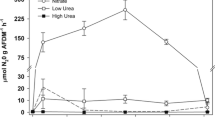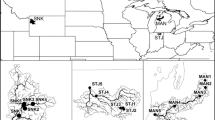Abstract
Tidal freshwater wetlands receive and retain significant amounts of water, nutrients, and sediment loads from terrestrial watersheds. Wetlands retain nutrients, particularly nitrogen, through microbial processing (e.g. denitrification), plant uptake, and burial. Previous research has provided data on these processes through plot studies and laboratory experiments; however, in situ validation of these results is necessary. Extending the localized measurements to the ecosystem scale requires an understanding of external controls on ecosystem retention processes, such as the determination of whether nitrogen retention is controlled by supply, temperature, or hydrologic transport. These controls were examined through a multi-scale, mass balance approach to measure nitrate retention in tidal freshwater wetlands of the Patuxent River, Maryland. Mass balance measurements of hydrologic and nitrate fluxes were conducted over a 3-year period on a range of marsh sizes. These mass balance results indicate that nitrate retention is not limited by incoming nitrate supply, and is not sensitive to the range of temperatures encountered during the growing season. Nitrate retention data composed of all marsh sites and seasons can be expressed as a simple function of water volume. This result suggests that nitrate retention is principally controlled by hydrologic transport in this tidal freshwater marsh ecosystem.







Similar content being viewed by others
References
Aber JD, Nadelhoffer KJ, Stuedler P, Melillo JM (1989) Nitrogen saturation in Northern forest ecosystems: excess nitrogen from fossil fuel combustion may stress the biosphere. BioScience 39:378–386
Aber JD, McDowell W, Nadelhoffer KJ, Magill A, Berntson G, Kamakea M, McNulty S, Currie W, Rustad L, Fernandez I (1998) Nitrogen saturation in temperate forest ecosystems: hypotheses revisited. BioScience 48:921–934
Abdalla M, Jones M, Smith P, Williams M (2009) Nitrous oxide fluxes and denitrification sensitivity to temperature in Irish pasture soils. Soil Use and Management 25:376–388. doi:10.1111/j.1475-2743.2009.00237.x
Ågren GI, Bosatta E (1988) Nitrogen saturation of terrestrial ecosystems. Environmental Pollution 54:185–197
Barendregt A, Swarth CW (2013) Tidal freshwater wetlands: variation and changes. Estuaries and Coasts 36:225–456. doi:10.1007/s12237-013-9626-z
Betlach MR, Tiedje JM (1981) Kinetic explanation for accumulation of nitrite, nitric oxide, and nitrous oxide during bacterial denitrification. Applied Environmental Microbiology 42:1074–1084
Boesch DF, Brinsfield RB, Magnien RE (2001) Chesapeake Bay eutrophication: scientific understanding, ecosystem restoration, and challenges for agriculture. Journal of Environmental Quality 30:303–320
Bowden WB (1987) The biogeochemistry of nitrogen in freshwater wetlands. Biogeochemistry 4:314–348
Boynton WR, Garber JH, Summers R, Kemp WM (1995) Inputs, transformations, and transport of N and P in Chesapeake Bay and selected tributaries. Estuaries 18:285–314
Boynton WR, Hagy JD, Cornwell JC, Kemp WM, Greene SM, Owens MS, Baker JE, Larsen RK (2008) Nutrient budgets and management actions in the Patuxent River Estuary, Maryland. Estuaries and Coasts 31:623–651. doi:10.1007/s12237-008-9052-9
Burgin AJ, Groffman PM (2012) Soil O2 controls denitrification rates and N2O yield in a riparian wetland. Journal of Geophysical Research 117, G01010. doi:10.1029/2011JG001799
Burgin AJ, Hamilton SH (2007) Have we overemphasized the role of denitrification in aquatic ecosystems? A review of nitrate removal pathways. Frontiers in Ecology and the Environment 5:89–96
Busnardo MJ, Gersberg RM, Langis R, Sinicrope TL, Zedler JB (2003) Nitrogen and phosphorus removal by wetland mesocosms subjected to different hydroperiods. Ecological Engineering 1:287–307
Chen Y–C, Chiu CL (2002) An efficient method of discharge measurement in tidal streams. Journal of Hydrology 265:212–224
Cooper AB (1990) Nitrate depletion in the riparian zone and stream channel of a small headwater catchment. Hydrobiologia 202:13–26
Cooper AB, Cooke JG (1984) Nitrate loss and transformation in 2 vegetated headwater streams. New Zealand Journal of Marine & Freshwater 18:441–450
Cornwell JC, Kemp WM, Kana TM (1999) Denitrification in coastal ecosystems: methods, environmental controls, and ecosystem level controls, a review. Aquatic Ecology 33:41–54
Correll DL (1997) Buffer zones and water quality protection: general principles. In: Burt TP, Goulding KWT, Pinay G, Haycock NE (eds) Buffer zones: their processes and potential in water protection. Quest Environmental, Harfordshire, pp 7–20
Davidson EA, Seitzinger SP (2006) The enigma of progress in denitrification research. Ecological Applications 16:2057–2063
Dodds WK, López AJ, Bowden WB, Gregory S, Grimm NB, Hamilton SK, Hershey AE, Martí E, McDowell WH, Meyer JL, Morrall D, Mulholland PJ, Peterson BJ, Tank JL, Valett HM, Webster JR, Wollheim W (2002) N uptake as a function of concentration in streams. Journal of North American Benthological Society 21:206–220
Ensign SH, Piehler MF, Doyle MW (2008) Riparian zone denitrification affects nitrogen flux through a tidal freshwater river. Biogeochemistry 91:133–150. doi:10.1007/s10533-008-9265-9
Ensign S, Siporin K, Piehler M, Doyle M, Leonard L (2013) Hydrologic versus biogeochemical controls of denitrification in tidal freshwater wetlands. Estuaries and Coasts 36:519–532. doi:10.1007/s12237-012-9491-1
Eyes on the Bay (1998) Maryland Department of Natural Resources. Eyes on the Bay: Water quality monitoring data, Annapolis, Maryland, USA. http://mddnr.chesapeakebay.net/eyesonthebay/index.cfm. Accessed 15 Sept 2012
Fisher DC, Oppenheimer M (1991) Nitrogen deposition and the Chesapeake Bay Estuary. Ambio 20:102–108
Fisher TR, Harding LW, Stanley DW, Ward LG (1988) Phytoplankton, nutrients, and turbidity in the Chesapeake, Delaware, and Hudson estuaries. Estuarine, Coastal and Shelf Science 27:61–93
Fisher TR, Hagy JD, Boynton WR, Williams MR (2006) Cultural eutrophication in the Choptank and Patuxent estuaries of Chesapeake Bay. Limnology and Oceanography 51:435–447
Hemond HF, Nuttle WK, Burke RW, Stolzenbach KD (1984) Surface infiltration in salt marshes: theory, measurement, and biogeochemical implications. Water Resources Research 20:591–600
Hill AR (1988) Factors influencing nitrate depletion in a rural stream. Hydrobiologia 60:111–122
Hirsch RM, Moyer DL, Archfield SA (2010) Weighted regressions on time, discharge, and season (WRTDS), with an application to Chesapeake Bay river inputs. Journal of American Water Resources Association 46:857–880. doi:10.1111/j.1752-1688.2010.00482.x
Holtan-Hartwig L, Dorsch P, Bakken LR (2002) Low temperature control of soil denitrifying communities: kinetics of N2O production and reduction. Soil Biology and Biochemistry 34:1797–1806
Hopfensperger KN, Kaushal SS, Findlay SEG, Cornwell JC (2009) Influence of plant communities on denitrification in a tidal freshwater marsh of the Potomac River, United States. Jounral of Environmental Quality 38:618–626. doi:10.2134/jeq2008.0220
Jenner, BA (2011) Geomorphic and hydrologic controls on tidal prism and inlet cross sectional area for Chesapeake Bay lagoons. Thesis, University of Maryland
Jordan TE, Correll DL, Weller DE (1993) Nutrient interception by a riparian forest receiving inputs from adjacent cropland. Journal of Environmental Quality 22:467–473
Keefe CW, Blodniker KL, Boynton WR, Clark CA, Frank JM, Kaumeyer NL, Weir MW, Wood KV, Zimmermann CF (2004) Nutrient analytical services laboratory standard operating procedures. Technical Report Number SS-80-04-CBL, Chesapeake Biological Laboratory
Lowrance R (1998) Riparian forest ecosystems as filters for nonpoint-source pollution. In: Pace ML, Groffman PM (eds) Limitations and frontiers in ecosystem science. Springer, New York, pp 113–141
Maag M (1997) Kinetic and temperature dependence of potential denitrification in riparian Soils. Journal of Environmental Quality 26:215–223
Martin TL, Kaushik NK, Trevors JT, Whiteley HR (1999) Review: denitrification in temperate climate riparian zones. Water, Air and Soil Pollution 111:171–186
McClain ME, Boyer EW, Dent CL, Gergel SE, Grimm NB, Groffman PM, Hart SC, Harvey JW, Johnston CA, Mayorga E, McDowell WH, Pinay G (2003) Biogeochemical hot spots and hot moments at the interface of terrestrial and aquatic ecosystems. Ecosystems 6:301–312
Merrill JZ, Cornwell JC (2000) The role of oligohaline marshes in estuarine nutrient cycling. In: Weinstein MP, Kreeger DA (eds) Concepts and controversies in tidal marsh ecology. Kluwer Academic Publishers, Dordrecht, Netherlands, pp 425–441
Neubauer SC (2008) Contributions of mineral and organic components to tidal freshwater marsh accretion. Estuarine, Coastal and Shelf Science 78:78–88
Neubauer SC, Anderson IC, Constantine JA, Kuehl SA (2002) Sediment deposition and accretion in a Mid-Atlantic (U.S.A.) tidal freshwater marsh. Estuarine. Coastal and Shelf Science 54:713–727
Nichols DS (1983) Capacity of natural wetlands to remove nutrients from wastewater. Journal Water Pollution Control Federation 55:495–505
Nixon SW (1987) Chesapeake Bay nutrient budgets - a reassessment. Biogeochemistry 4:77–90
Nixon S, Lee V (1986) Wetlands and water quality. Final Report. Dept. Army. Technical Report Y-86-2
Pasternack GB, Brush GS (1998) Sedimentation cycles in a river-mouth tidal freshwater marsh. Estuaries 21:407–415
Patrick WH Jr, Reddy KR (1976) Nitrification-denitrification reactions in flooded soils and water bottoms: dependence on oxygen supply and ammonium diffusion. Journal of Environmental Quality 5:469–472
Rabalais N, Turner RE, Wiseman WJ (2001) Hypoxia in the Gulf of Mexico. Journal of Environmental Quality 30:320–329
Sauer VB, Meyer RW (1992) Determination of error in individual discharge measurements. U.S. Geological Survey Professional Paper 92–144
Saunders DL, Kalff J (2001) Nitrogen retention in wetlands, lakes, and rivers. Hydrobiologia 443:205–212
Schindler DW (1998) Replication versus realism: the need for ecosystem-scale experiments. Ecosystems 1:323–334
Seitzinger SP (1988) Denitrification in freshwater and coastal marine systems: ecological and geochemical significance. Limnology and Oceanography 33:702–724
Seitzinger SP (1994) Linkages between organic matter mineralization and denitrification in eight riparian wetlands. Biogeochemistry 25:19–39
Seitzinger SP, Harrison JA, Böhlke JK, Bouwman AF, Lowrance R, Peterson B, Tobias C, van Drecht G (2006) Denitrification across landscapes and waterscapes: a synthesis. Ecological Applications 16:2064–2090
Seitzinger SP, Styles RV, Boyer EW, Alexander RB, Billen G, Howarth RW, Mayer B, van Breemen M (2002) Nitrogen retention in rivers: model development and application to watersheds in the Northeastern U.S.A. Biogeochemistry 57(58):199–237
Seldomridge E (2009) Importance of channel networks on nitrate retention in freshwater tidal wetlands, Patuxent River, MD. Thesis, University of Maryland
Seldomridge E (2012) Geomorphic, hydraulic, and biogeochemical controls on nitrate retention in tidal freshwater marshes. Dissertation, University of Maryland
Seldomridge E, Prestegaard K (2012) Use of geomorphic, hydrologic, and nitrogen mass balance data to model ecosystem nitrate retention in tidal freshwater wetlands. Biogeosciences 9:1407–1437. doi:10.5194/bgd-9-1407-2012
Sheibley RW, Jackman AP, Duff JH, Triska FJ (2003) Numerical modeling of coupled nitrification-denitrification in sediment perfusion cores from the hyporheic zone of Shingobee River, MN. Advances in Water Resources 26:977–987
Simpson RL, Good RE, Leck MA, Whigham DF (1983) The ecology of freshwater tidal wetlands. BioScience 33:255–259
Smullen JT, Taft JI, Macknis J (1982) Nutrient and sediment loads to the tidal Chesapeake Bay system. In: United States Environmental Protection Agency, Chesapeake Bay Program. Technical Studies: A Synthesis. Washington, D.C., pp 147–258
Snyder NJ, Mostaghimi S, Berry DF, Reneau RB, Hong S, McClellan PW, Smith EP (1998) Impact of riparian forest buffers on agricultural nonpoint source pollution. Journal of the American Water Resources Association 34:385–395
Solorzano L (1969) Determination of ammonia in natural waters by the phenolhypochlorite method. Limnology and Oceanography 14:799–801
Stanford G, Dzienia S, Vander-Pol RA (1975) Effect of temperature on denitrification rate in soils. Soil Science Society of America Proceedings 39:867–870
Swarth C, Peters D (1993) Water quality and nutrient dynamics of Jug Bay on the Patuxent River 1987-1992. Jug Bay Wetlands Sanctuary Technical Report, p 110
Turner RE, Rabalais NN (2003) Linking landscape and water quality in the Mississippi River Basin for 200 years. BioScience 53:563–572
USGS NWIS [United States Geological Survey National Water Information System]. 2012
USGS RIM [United States Geological Survey River Input Monitoring]. 2009. Chesapeake Bay River Input Monitoring Program. http://va.water.usgs.gov/chesbay/RIMP/index.html. Accessed 15 Sept 2012
Vidon P, Dosskey MG (2008) Testing a simple field method for assessing nitrate removal in riparian zones. Journal of the American Water Resources Association 44:523–534. doi:10.1111/j.1752-1688.2007.00155.x
Wigington PJ, Griffith SM, Field JA, Baham JE, Horwath WR, Owen J, Davis JH, Rain SC, Steiner JJ (2003) Nitrate removal effectiveness of a riparian buffer along a small agricultural stream in Western Oregon. Journal of Environmental Quality 32:162–170
Wollheim WM, Vörösmarty CJ, Peterson BJ, Seitzinger SP, Hopkinson CS (2006) Relationship between river size and nutrient removal. Geophysical Research Letters 33, L06410
Acknowledgments
Dr. Jeffrey Cornwell and Mike Owens, Horn Point Laboratory, University of Maryland Center for Environmental Sciences provided lab assistance and advice that greatly improved this project. We benefited from reviews of an earlier version of this manuscript by Tom Arsuffi, Jeffrey Cornwell, Margaret Palmer, Sujay Kaushal, and Wen-lu Zhu. This research was conducted under an award from the Estuarine Reserves Division, Office of Ocean and Coastal Resource Management, National Ocean Service, National Oceanic and Atmospheric Administration.
Author information
Authors and Affiliations
Corresponding author
Rights and permissions
About this article
Cite this article
Seldomridge, E., Prestegaard, K. Geochemical, Temperature, and Hydrologic Transport Limitations on Nitrate Retention in Tidal Freshwater Wetlands, Patuxent River, Maryland. Wetlands 34, 641–651 (2014). https://doi.org/10.1007/s13157-014-0530-5
Received:
Accepted:
Published:
Issue Date:
DOI: https://doi.org/10.1007/s13157-014-0530-5




